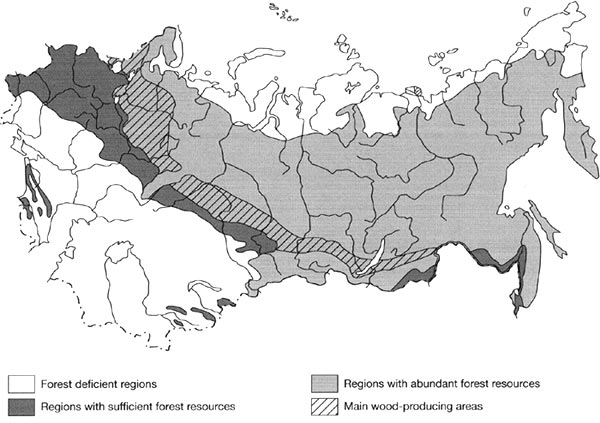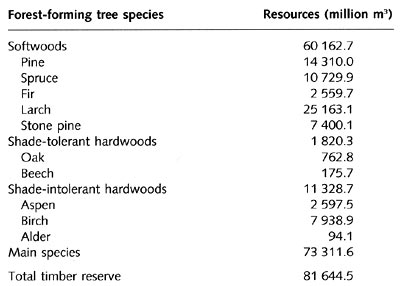Please put an active hyperlink to our site (www.rusnature.info) when you copy the materials from this page
Environmental problems of Northern Eurasia
Deforestation and Degradation of Forests
<<< The Aral Sea: conclusions
| Environmental Problems Index | The
History and Scale of Deforestation >>>
Introduction
The former Soviet Union (FSU) is a forested region. Russia contains 96 per cent of
regional forest and almost two-thirds of its territory, mainly in Siberia and the Far
East, are occupied by forests (Figure 23.1).

Fig. 23.1 Forest resources of Northern Eurasia
Closed forests cover 756 million hectares in Russia and Russia's reserve of timber
exceeds 81.6 billion m3 or a quarter of the world's total stock. The annual
growth reaches 822 million m3 (Les Rossii, 1995; Novaya Rossiya, 1995). Russia
possesses the largest reserves of timber in the Northern Hemisphere and its forested
territory (over 20 per cent of the world's total) is larger than the forested territory of
Canada, the United States, Finland, Sweden, and Norway combined. The composition of North
Eurasian forests varies greatly from the typical taiga species such as larch (which
occupies 258 million hectares), pine (114 million), and stone pine (37 million) to the
subtropical forests of Transcaucasia. Conifers and larch, which are commercially valuable,
account for 90 per cent of Russia's forests and constitute over a half of the world's
growing stock (Table 23.1).

Table 23.1 Forest resources by tree species
For centuries the forest resources of Northern Eurasia have been treated as
inexhaustible. Over much of the Asiatic territory, remote and unsuitable for agriculture,
forests of exceptional scale still remain in the state of wilderness. However, it is the
vastness and abundance of forest that may provoke its decline. The major problem of forest
management in the FSU as Barr (1987) puts it 'seems to lie in the very size and visibility
of the forest resource'. In many densely populated regions the expansion of arable
agriculture and use of wood in industry and for construction purposes have depleted the
forest stock and changed the distribution of forests immensely.
There are two major types of changes: deforestation and degradation of forests.
'Deforestation' refers to forest clearance. The term 'degradation' is used to describe the
adverse effects on forests (such as temporary clearance, modification of composition or
replacement of forests by inferior woody covers) which do not involve complete and
permanent clearance. Deforestation occurred in central European Russia, the Ukraine, the
Volga region, in the Caucasus, and Transcaucasia mainly between the 15th and 19th
centuries as more land was brought into agricultural production. In other areas with lower
agricultural potential (e.g., the European north) forests became fragmented, less
productive, and the most valuable species have been extracted.
Forests are often valued in commercial terms. However, when discussing the role of
forests in life and economy and analysing potential consequences of deforestation and
degradation, various aspects of forest use, which may come under threat, should be
considered. Forest has always provided food and shelter to its dwellers. Various forest
products, such as berries, nuts, and mushrooms, have been important components of human
diet for centuries. Many domestic plants and animals originate from forests and over 300
plant species used in contemporary medicine occur in the forests of Northern Eurasia. It
has been estimated that in 1997, the forests of Russia had over 4700 tonnes of berries,
2200 tonnes of mushrooms, and 7800 tonnes of birch juice, which has been traditionally
used in Russia. Forests provide habitats for animals and harbour about 100 mammal and 300
bird species. Many of these animals are hunted commercially and by the indigenous tribes.
Forests play important ecological, aesthetic, and recreational roles. Its cultural
importance is reflected in the languages, folklore and literature of many peoples of
Northern Eurasia. The cult of sacred trees and groves still exists in northern European
Russian, in the Volga and Transbaikal regions and in the Far East.
Forests are closely associated with the protection of global biodiversity and
maintaining environmental balance through their role in the carbon cycle. Forests account
for a greater part of the carbon exchange between the atmosphere and terrestrial biosphere
than any other biome. In this context, the forests of Northern Eurasia are particularly
important because they cover an extremely large area and most of Siberia and the Far East
accommodate virgin forests. It is, therefore, the condition and management of forests in
Northern Eurasia that determines to a large degree whether the terrestrial biosphere is a
net sink or a net source of carbon. At present, national and international environmental
strategies are aimed at stabilization and reduction of carbon dioxide (CO2)
emissions and although direct reduction of emissions from burning fossil fuel can be very
expensive, forests of Northern Eurasia have a potential to be managed for the purposes of
carbon sequestration.
<<< The Aral Sea: conclusions
| Environmental Problems Index | The
History and Scale of Deforestation >>>
Contents of the Deforestation and Degradation
of Forests section:
Other sections of Environmental Problems of Nortern Eurasia:
|
|